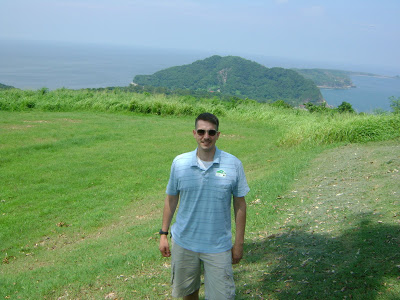 Chris Krueger on Corregidor Island, Philippines
Chris Krueger on Corregidor Island, Philippines
Tuesday, 11 August 2009
We pulled into anchorage, and waited the normal several hours before we were able to get on the liberty boats to head off to the pier. As usual, there was lots to do before I could leave. But JB, JPATT, and I headed out to Manila, got a cab, and checked into JB and JPATT’s hotel. I didn’t get a hotel room because I wanted to save money and I had duty later on during the port on the ship anyway. After checking into the hotel, we went to the best Thai food restaurant I’ve ever been to. It was at another hotel, and I forget the name of it, but it was great. And of course, in a city of 11 million people, we run into a huge group of other American navy guys being loud and obnoxious at the restaurant. 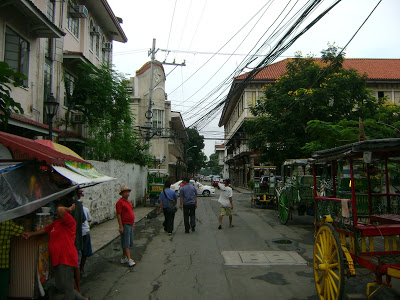 The cab rides were interesting, running through the streets crowded with jeepney’s, which are basically stretch limousine jeeps that are private, independent taxi services. After that, I headed back to the ship.
The cab rides were interesting, running through the streets crowded with jeepney’s, which are basically stretch limousine jeeps that are private, independent taxi services. After that, I headed back to the ship.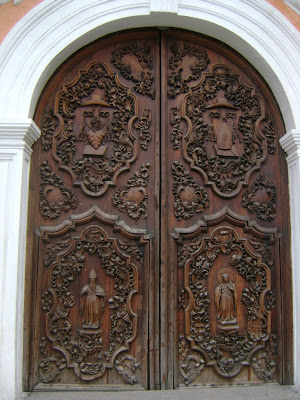 “Church of San Agustin. Oldest stone church in the Philippines. Plans were approved in 1586. Construction started in 1587 and completed in 1607….Its architect was Juan Macias. It has withstood many earthquakes from 1645 up to the present and survived the British invasion in 1762, the Spanish-American War in 1898 and the Japanese invasion in 1942. The church choir has 68 carved molave seats with narra inlaids, an artistic lectern and parchment cantorals of the 17th and 18th centuries. The church and its graves were profaned during the British occupation of Manila in 1762. The ashes of early Spanish conquistadores Legazpi, Salcedo, Lavezares, and blessed Pedro de Zuniga and others now rest in the easternmost chapel of the transept. Terms for the American occupation of Manila were prepared in the vestry of the church in 1898. The First Philippine Plenary Council was held here in 1953. Chosen as a World Heritage Site by Unesco in 1993.” Plaque at the Church of San Agustin (above)
“Church of San Agustin. Oldest stone church in the Philippines. Plans were approved in 1586. Construction started in 1587 and completed in 1607….Its architect was Juan Macias. It has withstood many earthquakes from 1645 up to the present and survived the British invasion in 1762, the Spanish-American War in 1898 and the Japanese invasion in 1942. The church choir has 68 carved molave seats with narra inlaids, an artistic lectern and parchment cantorals of the 17th and 18th centuries. The church and its graves were profaned during the British occupation of Manila in 1762. The ashes of early Spanish conquistadores Legazpi, Salcedo, Lavezares, and blessed Pedro de Zuniga and others now rest in the easternmost chapel of the transept. Terms for the American occupation of Manila were prepared in the vestry of the church in 1898. The First Philippine Plenary Council was held here in 1953. Chosen as a World Heritage Site by Unesco in 1993.” Plaque at the Church of San Agustin (above)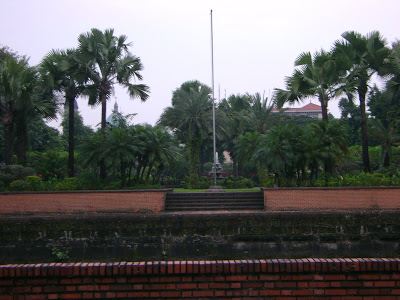 Wednesday, 12 August 2009
Wednesday, 12 August 2009
This was kind of my free day. I had to wait on my OIC, because you have to have a liberty buddy in port and he was mine for the day, so we didn’t get off the ship until almost noon. After that we went and picked up JPATT and then went to Fort Santiago, which was the Spanish fort which was the center of Manila and which defended the city for hundreds of years.
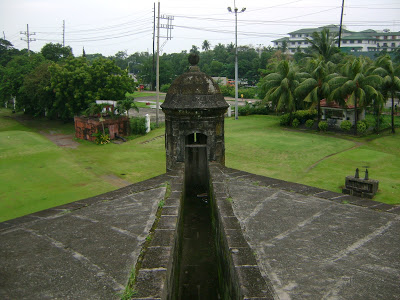 “Fort Santiago. One of the oldest fortifications in Manila. Built in 1571, on the site of the native settlement of Rajah Soliman. First fort was a palisaded structure of logs and earth. Destroyed in the Limahong attack in 1574. Stone fort built between 1589 and 1592. Damaged in the 1645 earthquake. Repaired and strengthened from 1658 to 1663. Became the headquarters of the British Occupation Army from 1782 to 1764. Former headquarters of the Philippine Division of the U.S. Army. Occupied by the Japanese military in 1942 where hundreds of civilians and guerillas were imprisoned, tortured and executed. Destroyed in the Battle of Manila in 1945. Used as depot of the U.S. Transportation Corps before turnover to the Philippine Government in 1946. Declared Shrine of Freedom in 1950. Restoration and maintenance of the fort began in 1951 under the National Parks Development Committee.” From Fort Santiago plaque
“Fort Santiago. One of the oldest fortifications in Manila. Built in 1571, on the site of the native settlement of Rajah Soliman. First fort was a palisaded structure of logs and earth. Destroyed in the Limahong attack in 1574. Stone fort built between 1589 and 1592. Damaged in the 1645 earthquake. Repaired and strengthened from 1658 to 1663. Became the headquarters of the British Occupation Army from 1782 to 1764. Former headquarters of the Philippine Division of the U.S. Army. Occupied by the Japanese military in 1942 where hundreds of civilians and guerillas were imprisoned, tortured and executed. Destroyed in the Battle of Manila in 1945. Used as depot of the U.S. Transportation Corps before turnover to the Philippine Government in 1946. Declared Shrine of Freedom in 1950. Restoration and maintenance of the fort began in 1951 under the National Parks Development Committee.” From Fort Santiago plaque
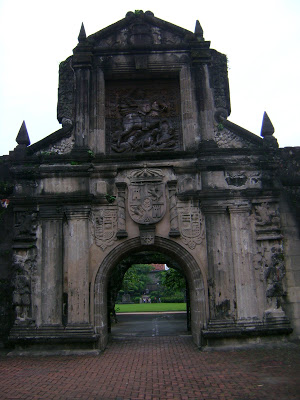 The fort is centered in an area known as Intramuros, or the “walled city”. Here is what the tour description said of it: “The first phase of this excursion takes you on a tour of Intramuros, the “walled city”. Constructed in 1571, during the period of Spain’s colonization of the Philippines, it is comprised of European buildings and churches that have been replicated in different parts of the country. It had been one of the world’s best preserved medieval cities. Here, dungeons and old churches share space with art galleries and theaters.”
The fort is centered in an area known as Intramuros, or the “walled city”. Here is what the tour description said of it: “The first phase of this excursion takes you on a tour of Intramuros, the “walled city”. Constructed in 1571, during the period of Spain’s colonization of the Philippines, it is comprised of European buildings and churches that have been replicated in different parts of the country. It had been one of the world’s best preserved medieval cities. Here, dungeons and old churches share space with art galleries and theaters.”
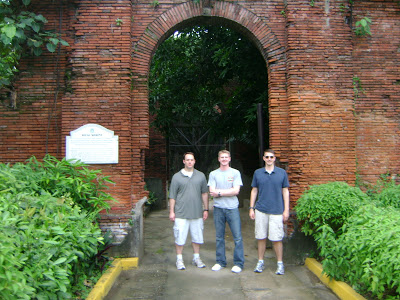 We didn’t take “the tour” though, we just grabbed a cab and went and saw it on our own, then met up with the det 3 guys from the carrier and went and had some Pilipino food, and then out to a Pilipino club for drinks, and then we went back to the pier to get back on the ship for the evening by midnight.
We didn’t take “the tour” though, we just grabbed a cab and went and saw it on our own, then met up with the det 3 guys from the carrier and went and had some Pilipino food, and then out to a Pilipino club for drinks, and then we went back to the pier to get back on the ship for the evening by midnight.

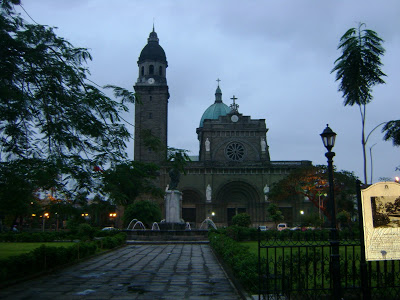 Thursday, 13 August 2009
Thursday, 13 August 2009Today was my duty day. I had to give a public affairs tour of the flight deck, hangar, and helicopter to visiting Philippine dignitaries and to American embassy personnel in the morning. After that, I had to go to the pier via liberty boat to start my shore patrol, where I go patrol the streets of Manila in a particular area and make sure the sailors don’t do anything stupid and make sure everyone gets back to the boat prior to liberty expiration. This part is never fun, and today was no exception. I didn’t get back to the boat until like 3 in the morning.
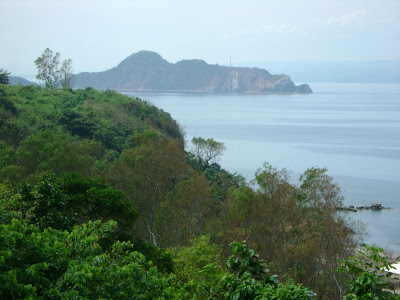 Friday, 14 August 2009
Friday, 14 August 2009Today was my last day in port, and despite getting about an hour of sleep, I was really excited about my tour of Corregidor Island.
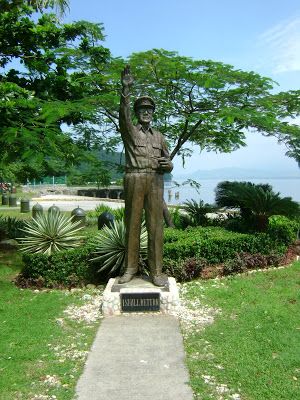 Here is what the tour description said of it: “This historic tour will take you back in time to when the Allied forces under the command of GEN. Douglas MacArthur carried out a valiant and heroic stand and delayed the advance of Japanese troops in the province of Bataan. Philippine and American forces held out at Corregidor for 27 days against great odds until they were forced to surrender on May 6, 1942. Also known as “the Rock”, Corregidor was a stronghold for the Allies during the war.” We had to take a bus to another pier, get on another boat for an hour boat ride to Corregidor island at the entrance to Manila Bay, and then get on another bus for the actual tour.
Here is what the tour description said of it: “This historic tour will take you back in time to when the Allied forces under the command of GEN. Douglas MacArthur carried out a valiant and heroic stand and delayed the advance of Japanese troops in the province of Bataan. Philippine and American forces held out at Corregidor for 27 days against great odds until they were forced to surrender on May 6, 1942. Also known as “the Rock”, Corregidor was a stronghold for the Allies during the war.” We had to take a bus to another pier, get on another boat for an hour boat ride to Corregidor island at the entrance to Manila Bay, and then get on another bus for the actual tour.
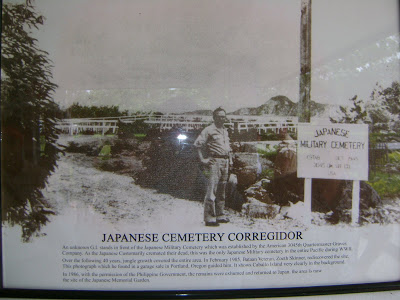 “Japanese Cemetery Corregidor. An unknown G.I. stands in front of the Japanese Military cemetery which was established by the American 3045th Quartermaster Graves Company. As the Japanese customarily creamated their dead, this was the only Japanese Military cemetery in the entire Pacific during WWII. Over the following 40 years, jungle growth covered the entire area. In February 1985, Bataan Veteran Zoeth Skinner rediscovered the site. This photograph, which he found in a garage sale in Portland, Oregon guided him. It shows Caballo Island very clearly in the background. In 1986, with the permission of the Philippine Government, the remains were exhumed and returned to Japan. The area is now the side of the Japanese Memorial Garden.”
“Japanese Cemetery Corregidor. An unknown G.I. stands in front of the Japanese Military cemetery which was established by the American 3045th Quartermaster Graves Company. As the Japanese customarily creamated their dead, this was the only Japanese Military cemetery in the entire Pacific during WWII. Over the following 40 years, jungle growth covered the entire area. In February 1985, Bataan Veteran Zoeth Skinner rediscovered the site. This photograph, which he found in a garage sale in Portland, Oregon guided him. It shows Caballo Island very clearly in the background. In 1986, with the permission of the Philippine Government, the remains were exhumed and returned to Japan. The area is now the side of the Japanese Memorial Garden.”When Mari and I were in Nagasaki, Japan, in February we went to the temple were the remains were relocated.
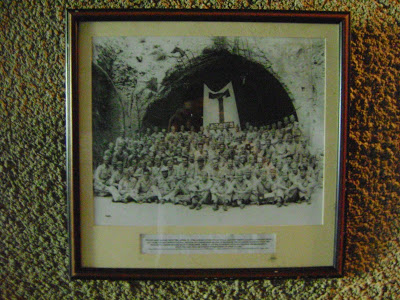 The guides gave us a tour of the entire island. We saw the general low land areas were most of the landings were made, saw where MacArthur departed the Philippines for Australia and said “I shall return”, and then went to Malinta tunnel. This is where that famous Aggie Muster took place during WWII under General Moore, and the front of the tunnel is where the famous picture was taken. Well, at the end of the tunnel and after the tour of it, what did I see? An original picture of the Aggie Muster hanging on the wall. It was really neat.
The guides gave us a tour of the entire island. We saw the general low land areas were most of the landings were made, saw where MacArthur departed the Philippines for Australia and said “I shall return”, and then went to Malinta tunnel. This is where that famous Aggie Muster took place during WWII under General Moore, and the front of the tunnel is where the famous picture was taken. Well, at the end of the tunnel and after the tour of it, what did I see? An original picture of the Aggie Muster hanging on the wall. It was really neat.
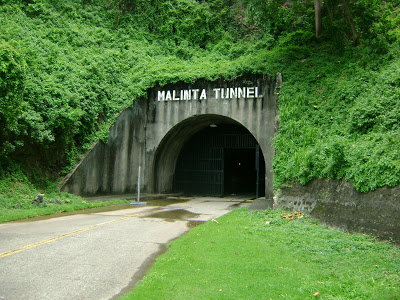 I took LOTS of pictures. Anyway, then we continued to drive around and look at stuff, and had lunch. Afterwards, we headed off to the top of the island and checked out the old American military base there. It was weird, as if I were looking at Atsugi, or Mayport, or any other base I’ve lived/worked at, with BOQ’s, mess halls, tennis courts, etc., and then to see what it looks like after it got obliterated by hundreds of thousands of tons of explosives.
I took LOTS of pictures. Anyway, then we continued to drive around and look at stuff, and had lunch. Afterwards, we headed off to the top of the island and checked out the old American military base there. It was weird, as if I were looking at Atsugi, or Mayport, or any other base I’ve lived/worked at, with BOQ’s, mess halls, tennis courts, etc., and then to see what it looks like after it got obliterated by hundreds of thousands of tons of explosives.
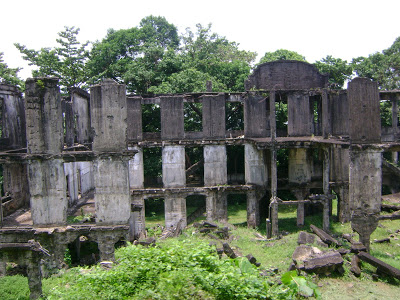 “Middleside Barracks, located on a plateau at the middle of Corregidor Island, were the quarters of the 60th Coast Artillery anti-aircraft regiment, United States Regular Army, and the 91st Coast Artillery, Philippine Scouts. The barracks, built in 1915 using advanced concrete construction technology of prefabricated and modular metal lathe reinforcements, consisted of two three-storey buildings which infused the sensibilities of tropical design through the use of high ceilings, wide capiz shell sliding windows and perimeter galleries to allow good ventilation and protect the rooms from the direct heat of the sum. The Middleside Barracks were destroyed by Japanese bombs on December 29, 1941.” Middleside Barracks Plaque (above)
“Middleside Barracks, located on a plateau at the middle of Corregidor Island, were the quarters of the 60th Coast Artillery anti-aircraft regiment, United States Regular Army, and the 91st Coast Artillery, Philippine Scouts. The barracks, built in 1915 using advanced concrete construction technology of prefabricated and modular metal lathe reinforcements, consisted of two three-storey buildings which infused the sensibilities of tropical design through the use of high ceilings, wide capiz shell sliding windows and perimeter galleries to allow good ventilation and protect the rooms from the direct heat of the sum. The Middleside Barracks were destroyed by Japanese bombs on December 29, 1941.” Middleside Barracks Plaque (above)
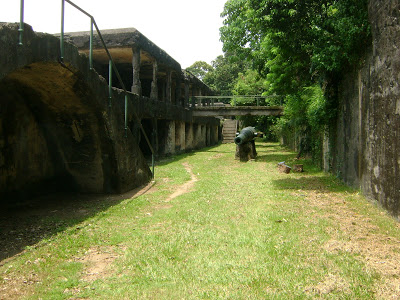 They had a museum and WWII monument at the top which was interesting because the memorial had a dome that allowed sunlight to hit a specific spot one day a year, and that day is the day that the Pilipino surrender of Corregidor, and all of the Philippines was signed over to Japan. Why on earth would you want to commemorate that kind of defeat? I thought that was ridiculous. If America ever memorializes one of its defeats, I don’t plan on just accepting it and sitting on my thumbs. And the Alamo doesn’t fall under that category—that’s different because it rallied Americans of all walks of life together toward one goal.
They had a museum and WWII monument at the top which was interesting because the memorial had a dome that allowed sunlight to hit a specific spot one day a year, and that day is the day that the Pilipino surrender of Corregidor, and all of the Philippines was signed over to Japan. Why on earth would you want to commemorate that kind of defeat? I thought that was ridiculous. If America ever memorializes one of its defeats, I don’t plan on just accepting it and sitting on my thumbs. And the Alamo doesn’t fall under that category—that’s different because it rallied Americans of all walks of life together toward one goal.
 “Sleep, my sons, your duty done
“Sleep, my sons, your duty doneFor freedom’s light has come
Sleep in the silent depths of the sea
Or in your bed of hallowed sod
Until you hear at dawn
The low, clear reveille of God.”
Inscription in the Pacific War Memorial on Corregidor Island
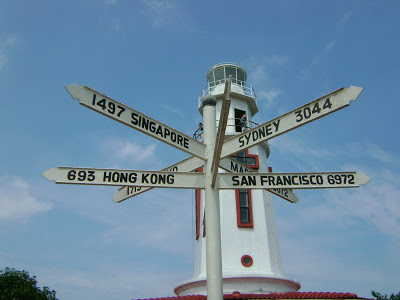 Anyway, after the tour we took our boat back and bussed back to the pier, then JB and JPATT and I went to the Mall of Asia, which is actually the largest Mall in all of Asia, walked around, did some shopping, had dinner at kind of a mardi gras themed french/Italian restaurant, went to an arcade and played some video games, and then headed back to the ship for the night.
Anyway, after the tour we took our boat back and bussed back to the pier, then JB and JPATT and I went to the Mall of Asia, which is actually the largest Mall in all of Asia, walked around, did some shopping, had dinner at kind of a mardi gras themed french/Italian restaurant, went to an arcade and played some video games, and then headed back to the ship for the night.
Saturday, 15 August 2009
We got underway this morning for the last part of our cruise. Thus begins the final countdown until I see Mari again!

